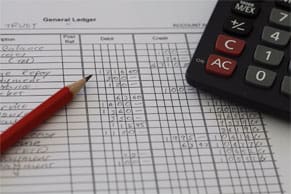Bad debt expense — money that a business assumes it will never collect — is an unfortunate reality for any business that extends credit to its customers. More than just a number on an income statement, bad debt expense can impact a company’s cash flow and its overall financial health, which makes managing it effectively an essential business accounting goal. This article delves deeply into what bad debt expense is, why it matters, how to calculate it and strategies to use to minimize it, all of which can help businesses maintain healthy cash flow and profitability.
What Is Bad Debt Expense?
When a company extends credit to a customer, it’s essentially taking a risk: It’s betting that the customer will pay the amount owed. If the customer doesn’t pay, the business absorbs the loss. Bad debt expense is the term accountants use to refer to the portion of accounts receivable that they anticipate will not be collected. Understanding and managing bad debt expense is important because it helps businesses improve cash flow and make sensible decisions. For instance, a high level of bad debt expense might indicate that a company’s credit policies are too lenient and need to be tightened. Or it might signal that the company needs to improve its accounts receivable collection processes.
Key Takeaways
- Bad debt expense, money that a business assumes it will never collect, can significantly impair a company’s cash flow and overall profitability.
- Effective management of bad debt expense is essential for any business that extends credit to its customers.
- Accounting software can play a key role in managing bad debt by automating tedious tasks, improving the speed and accuracy of customer invoices and allowing AR teams to focus on strategic work.
Bad Debt Expense Explained
Only businesses that sell on credit and use accrual-basis accounting will ever have bad debt expense. In accrual accounting, revenue is recognized when it’s earned and expenses when they’re incurred, regardless of when money changes hands. So, companies often recognize revenue before the cash arrives in their accounts. This creates an accounting challenge: How do you account for a customer who fails to pay an invoice months after a sale? The solution is bad debt expense accounting, which provides a way to reverse recorded revenue in subsequent accounting periods when receivables become uncollectible.
To avoid unpleasant down-the-road surprises, many companies use their historical experience of bad debt expense to estimate a reserve for bad debt at the same time as they record revenue. That way, if customers fail to pay later, the loss reduces the reserve fund without actually changing the company’s income statement (aka P&L, or profit and loss statement). For example, a company that sells $1,000 worth of goods on credit might estimate that 5% of its credit sales will not be collected and would record a bad debt reserve of $50.
It’s important to note that bad debts are not always all-or-nothing affairs. Especially when a company and its customer disagree over an aspect of a sale, such as the quality level, the customer will pay a portion of the total owed — known as a “short pay.” In such cases, the unpaid portion becomes a bad debt expense.
Also, in general, the longer an invoice goes past due, the less likely it is to be paid. So, anything a company can do to shorten the time between billing and payment helps to reduce bad debt expense — especially for companies that bill in arrears, which means they’ve already provided the value to the customer before sending the invoice.
Causes of Bad Debt
This section might just as well be called “Reasons Customers Don’t Pay Their Bills.” Bad debt is often a result of various factors that delay or prevent customers from paying. Understanding these causes can help businesses develop strategies to minimize bad debt and improve cash flow.
- Disconnected AR systems: One of the primary causes of bad debt is an internal disconnect between a company’s accounts receivable (AR) department and business units or sales teams. Such disconnects can lead to miscommunication, faulty bills and/or delays in invoicing, all of which increase the likelihood of customer confusion, disputes — and uncollected invoices.
- Disagreements: Disputes over charges often lead to bad debts. If customers believe they have been charged incorrectly, their first reaction usually is refusal to pay. The longer it takes to resolve the disagreement, the less likely it becomes that they’ll pay the bill.
- Bankruptcy: Customers who declare bankruptcy are, by definition, less able to fulfill their payment obligations. It’s important to check a business’s credit scores and overall financial health before extending it much credit.
- Poor communication: Misunderstandings around payment terms can also lead to payment delays and potential bad debt. For example, a customer might misunderstand the payment deadline due to unclear invoice terms, leading to late payment or nonpayment.
If a company finds itself in a bad debt situation for one of these reasons, it’s often possible to collect at least a portion of the amount owed, with the rest becoming bad debt expense. But businesses can take many proactive steps to minimize the fallout from these causes. For instance, automating AR processes can improve collaboration between operating units and the AR team while also increasing the accuracy of customer invoices, which minimizes disagreements. The challenge here is that delays have ripple effects. If a company has trouble collecting its receivables, it won’t be long before it may have trouble paying its own obligations.
Accounting for a Bad Debt Expense
The key thing to keep in mind when accounting for bad debt expense is the matching principle. The goal is to match the expense of uncollectible receivables in the same period, or as close as possible to the same period, as the revenue the receivables represent. Following this principle helps a company’s financial reporting give a clearer and more accurate picture of its financial health for any given reporting period. The advantages and disadvantages of the two main accounting methods for bad debt expense relate to that matching principle — they differ in precision and in how well they match revenue and bad debt expense.
Direct Write-Off Method
The direct write-off method records the exact amount of uncollectible accounts as they are identified. When a company determines that a specific customer invoice is uncollectible, it writes off, or removes, the invoice from its accounts receivable. The advantage of this approach is its accuracy — accountants write off bad debt expense invoice by invoice, at the moment they determine that the amount cannot be collected. So, for example, if ABC Co. invoices Customer Z for $2,000 and the customer ends up paying only $1,500, it records a $500 bad debt expense with the journal entry shown below.
But this method is only allowed under U.S. Generally Accepted Accounting Principles (GAAP) when the amounts involved are not material to a company’s financial health. This is because the direct method doesn’t do a good job of matching revenue and bad debt expense in the same reporting period.
| Date | Account | Debit | Credit |
|---|---|---|---|
| 3/4/22 | Bad Debt Expense — Customer Z Inv#1234 | $500.00 | |
| Accounts Receivable — Customer Z Inv#1234 | $500.00 | ||
| To record the write off a short pay from Customer Z. |
Allowance Method
The allowance method is recommended, under GAAP guidelines, for all bad debt amounts. To use this method, businesses estimate how much of their current-period AR will likely turn into bad debt and report that estimate in the same period as the revenue and receivables. The estimate is recorded as a bad debt expense on the income statement and as a contra asset (in this instance, the Allowance for Doubtful Accounts) on the balance sheet, reducing the AR asset to the amount the company actually expects to collect. In the future, when an invoice is deemed uncollectible, the AR is written off against that allowance account on the balance sheet and, therefore, doesn’t have any impact on the P&L in that period.
It’s important to note that any type of estimated allowance is subject to judgment and, thus, if a company wanted to, it could manipulate that judgment. Because there’s no specific, correct answer, independent auditors pay careful attention to reviewing reserves, such as bad debt expense allowances. They try to determine whether the reserves are justifiable, within the appropriate level of materiality for the company.
There are multiple ways to estimate bad debt expense, all of which benefit when viewed in light of historical bad debt data.
- Percentage of sales: This approach to estimating bad debt expense takes a company’s current-period total revenue and multiplies it by the historical average percentage of total revenue that the company fails to collect. So, if the company booked total sales of $1 million in its current period and knows that it has historically failed to collect 5% of its revenue, it would record $50,000 in the contra asset account and $50,000 in bad debt expense, so that net revenue on the P&L would be $950,000 for the period. The formula is:
- Percentage of receivables: When a business has a mix of credit and cash sales, the percentage of receivables formula provides a more precise way to estimate bad debt expense. Instead of using the historical percentage of total sales that went uncollected, this formula uses the historical percentage of AR that was never collected. And, instead of multiplying by total sales, this formula uses total credit sales, which should be equivalent to the period’s receivables balance. The formula is:
- Aging schedule: The aging schedule approach is a more detailed version of the percentage of receivables method — and, therefore, it is more precise. An aging schedule shows how long an invoice has been past due and puts it in a category, such as current, zero to 30 days past due, 31 to 60 days past due or 61 to 90 days past due. It assigns estimates of what percentage will be uncollected by category, with a higher percentage going to older invoices because they’re less likely to be collected. The formula, which must be applied separately to each category, is:
Percentage of sales = Percentage of sales estimated uncollectible × Total sales
Percentage of receivables = Percentage of outstanding receivables estimated uncollectible × Receivables balance
Aging schedule = Percentage of outstanding receivables estimated uncollectible × Receivables balance (for each AR aging bucket, then added all together)
The following table shows how a typical aging schedule might look.
| Age | Balance | Estimated Percent Uncollectible | Estimated Amount Uncollectible |
|---|---|---|---|
| Current | $200,000 | 1% | $2,000 |
| 31 – 60 days | $50,000 | 5% | $2,500 |
| 61 – 90 days | $30,000 | 10% | $3,000 |
| Over 90 days | $20,000 | 20% | $4,000 |
| $300,000 | $11,500 |
| Date | Account | Debit | Credit |
|---|---|---|---|
| 3/4/22 | Bad Debt Expense | $11,500.00 | |
| Allowance for Doubtful Accounts | $11,500.00 | ||
| To adjust the allowance account for the current period’s estimated bad debt expense. |
Bad Debt Expense Example
Let’s delve into a practical example to better understand the concept of bad debt expense.
Fictional ABC Co. sells advertising on its news website. Customer XYZ buys a $2,000 ad. ABC generates an invoice and sends it to XYZ, along with a screenshot to prove that the ad appeared. But XYZ is upset that the ad received only 15,000 impressions, rather than the 20,000 impressions it expected. Instead of paying the invoice, XYZ disputes it — and the invoice begins to age. In the subsequent back-and-forth between ABC’s collection team and XYZ, an agreement is reached for XYZ to pay two-thirds of the full price, or $1,500 (short-paying the bill by $500).
Because ABC follows the allowance method and had previously established a bad debt reserve, the $500 bad debt expense is written off against the reserve via the following journal entry.
| Date | Account | Debit | Credit |
|---|---|---|---|
| 3/4/22 | Allowance for Doubtful Accounts | $500.00 | |
| Accounts Receivable — Customer XYZ Inv#9876 | $500.00 | ||
| To record the write off of an uncollectible amount from XYZ. |
7 Strategies to Minimize Bad Debt Expenses
The only way for a business to reduce its bad debt expense is to increase the collectability of its invoices. So, this section might just as easily be called, “How to Make Your Invoices as Collectible as Possible.” The seven strategies described below aim to eliminate potential causes of bad debt as early in the customer relationship as possible — in the case of No. 1, before the business even takes on a new customer. The strategies are listed from early to later in the billing process.
1. Strengthen Credit Policies and Criteria
Strong credit policies and criteria form the first line of defense against bad debts. A business that has stringent credit policies is less likely to extend credit to customers who pose a high risk of defaulting on their payments. This can significantly reduce the amount of bad debt expense the business incurs. A strong credit policy should require an up-front credit check on each new customer and set minimum requirements that customers must meet before the business extends credit sales. Credit policies need not set binary yes/no standards. Instead, a customer may be allowed to buy on credit only up to a certain amount — say, $10,000 — beyond which the customer would have to pay some of its older receivables before the business extends more credit. That approach is conceptually similar to a consumer credit card limit.
2. Perform Regular Credit Checks on Clients
Regular credit checks on clients enable businesses to continually monitor their customers’ creditworthiness. This can help businesses identify customers who are at risk of defaulting on their payments and take proactive steps to prevent this from happening. As part of this strategy, businesses should check on customers’ outstanding balances, to make sure they’re not growing beyond the explicit or implicit credit limits the business established for them and to assess the timeliness of each customer’s payments.
3. Establish Efficient Invoicing and Follow-Ups
Establishing efficient invoicing and follow-up processes improves a business’s rate of collectability. This is about the AR department’s billing process. The sooner a business can get an invoice to a customer and the more accurate that invoice is, and the more communication the business has with the customer about it, the more likely it is that the business will collect on the invoice. This means sending invoices promptly, implementing a system for tracking and managing accounts receivable and following up quickly with customers who have overdue payments. Unfortunately, there are typically many steps in the invoicing process, so any way a business can condense those steps is beneficial. Ideally, the entire process would be automated via an electronic invoicing system to optimize speed and accuracy.
4. Offer Early Payment Discounts
Offering early payment discounts is a simple and effective way to encourage customers to pay their invoices faster than they otherwise might. This helps businesses improve cash flow while reducing bad debt. The amount of the discount is not considered part of bad debt expense. Instead, early-pay discounts are charged against revenue, using a separate contra revenue account.
5. Offer Customers Multiple Ways to Pay
Offering customers multiple ways to pay can make it easier for them to settle their invoices promptly. This can include acceptance of payments by credit card, bank transfer, mobile payment apps and other methods.
6. Use Third-Party Collection Agencies
Some companies opt for outsourcing past-due collections to a third-party agency. Collection agencies often have specific tools and expertise that can make them better at collecting overdue amounts, but, naturally, their services come with a cost. The main reasons companies use third-party agencies are because they don’t want to expend resources on in-house collectors and/or they don’t want to be directly involved in the awkward business of debt collection from customers.
7. Regularly Monitoring KPIs and Dashboards
Regular monitoring of key performance indicators (KPIs) via dashboards can help businesses track their rate of collectability and identify trends that could impact their bad debt expense. Businesses should perform frequent and rigorous reviews of KPIs for AR aging, comparing them to preestablished benchmarks in order to catch potentially problematic receivables before they become bad debt. Such reviews should include, for example, KPIs for days sales outstanding and the top 10 customers with the largest outstanding receivables balances. This can enable businesses to identify specific proactive steps to improve their rate of collectability and reduce their bad debt expense.
Reduce Bad Debt Expenses With NetSuite Accounting Software
Businesses face challenges when managing bad debt expense, not least because the risks involved in extending trade credit to customers and tracking AR aging can directly affect a company’s bottom line. NetSuite cloud accounting software provides a comprehensive solution for managing bad debt expense through advanced features that automate AR processes, enhance customer credit management and provide real-time financial reporting and analytics. By automating manual invoicing processes, businesses can improve the speed and accuracy of customer invoices, which reduces the likelihood of late or missed payments. For example, NetSuite AR software can automatically generate invoices from sales orders. In addition, NetSuite’s role-based dashboards allow AR teams to view real-time aging data by customer, salesperson or subsidiary, as well as for different aging categories, helping the teams to more effectively monitor accounts and take timely actions. With real-time insights into AR, businesses can proactively manage potential bad debt by taking action before a late payment becomes a larger issue.
Understanding and effectively managing bad debt expense is critical for any business that offers credit sales because a surprise in bad debt expense can significantly hurt a company’s overall profitability. Recognizing customers who have defaulted on payments and developing strategies to minimize such instances is crucial. Accounting software can play a key role in managing bad debt by automating tedious tasks so that billing is fast and accurate, and AR teams can focus on the strategic work of uncovering causes of payment delays and communicating more closely with customers.
#1 Cloud
Accounting
Software
Bad Debt Expense FAQs
What is an example of a bad debt expense write-off?
An example of a bad debt expense write-off is when a company sells goods on credit to a customer who later refuses or is unable to pay the invoice. Once the company knows that a specific invoice will not be paid, it writes off that invoice as a bad debt expense, eliminating it from receivables and reducing net revenue.
How do you record a bad debt expense?
To establish a reserve for bad debt expense, a company debits (increases) its Bad Debt Expense account on its income statement and credits (increases) its Allowance for Doubtful Accounts on its balance sheet. Subsequently, when you write off an invoice under the allowance method, the debit moves to the Allowance for Doubtful Accounts, which reduces that account’s balance. You credit the accounts receivable account, which reduces the receivable. Both of those are balance sheet accounts. Because the Allowance for Doubtful Accounts is a contra asset account, the two entries offset each other and net to zero.
Is bad debt expense income?
Bad debt expense is not income. It’s a cost of doing business on credit sales — an expense that a company incurs when it realizes that it cannot collect a receivable.
Is bad debt an operating expense?
Yes, bad debt is an operating expense. It is part of the cost of selling goods or services on credit.
What’s the difference between bad debt and doubtful accounts?
Bad debt refers to accounts receivable that a company has determined will not be collected and is recorded as an expense on the company’s income statement. Doubtful accounts is a reserve on the balance sheet that is an estimate of receivables that a company thinks it might not collect. The difference lies in the degree of certainty about noncollection.









